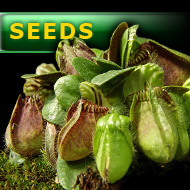.jpg)

today: 804
week: 6826
Total: 1701888
Mexican Butterworts
Mexican Pinguicula / Mexican butterworts / Pings
About
Mexican pinguicula are found scattered around the desert like climate of Mexico and parts of South America. They catch insects on waxy leaves and are a generally fun and versatile addition to your collection.
Pots and Substrate
Use pots that are 4cm in diameter or larger. The general rule is that a bigger pot equals a more stable environment. As for substrate, use a mix of peat, perlite and/or vermiculite or silica sand. I personally prefer sand or vermiculite, as perlite tends to float to the top and grow algae. I have also had success using volcanic rock.
It is recommended that you repot your pings every two years when they are just coming out of their dormant stage. For Europe, North America and Asia, this usually occurs in March, and in Australia, New Zealand, South Africa and South America, your best bet is in September.
To stimulate new growth, when re-potting you should remove as many old or dead leaves and roots as possible without harming the plant. The remaining rosette should be placed at or above the substrate level and not buried beneath it like some kind of bulb.
Usually, you do not need to fertilize your plant, as it will catch insects on its own, and it is never a good idea to use fertilized medium, though if you feel that supplementation is necessary, many growers have had success with products such as Maxsea or other orchid/nepenthes fertilizer, in a very dilute solution. However I recommend that you do your own research before trying this.
Environment and watering
They prefer warm temperatures 68-77°F (20-25°C) in the summer and 41-50°F (5-10°C) in the winter. The winter period is colder and dryer, with some varieties going dormant and forming succulent like leaves as a way of storing water.
Most Mexican Pings are easy to hybridize and as with most plants, the hybrids are often more resilient than the progenitors. If your ping is healthy, it will flower frequently. Most can be successfully grown on a windowsill using the tray method, though some people will drill holes in rocks and water them with a spray bottle. However, this is not recommended until you are confident in your cultivation of the species.
In order to avoid rot, it is recommended to let the pot begin to dry before watering again. Humidity doesn’t need to be high, but it does help with dew production, so if your plants leaves don’t have a waxy dewy sheen, then you may consider raising the humidity.
In order to mimic their normal season changes, keep 1cm of water in the tray during the summer season and keep the soil barely moist during the winter. They prefer diffuse to full sun, within the range found on most windowsills. It is best to use reverse osmosis or distilled water, though pings have a higher tolerance for minerals than do most carnivorous plants.
Sowing
Seeds should be sewn on top of the substrate, which should consist of the same medium you use for your adult pings. If the seeds are covered, not as many will germinate. Keep your germination pot at 23 - 25°C, or 73 - 77°F. The soil should remain wet the entire time and high humidity will increase germination rates. Some people put a clear Ziploc bag over the pot for this reason. You will want to watch out for mold and remove it if and when it shows up. Germination should occur within 3-4 weeks and seedlings should be repotted within 2 months and grown as adult plants.
Pests and assorted other health problems
Pings are known to succumb to browning heart disease as well as slugs, snails and aphids which like to snack on the leaves. Orthene, DiazonIn or a nearby flea collar can help. European countries, mites can also be a problem. In that case Dicofol helps, as does a light misting of neem oil, which is a natural fungicide and pesticide. In the case of browning heart disease, repotting the plant and ceasing the tray method have been known to work, as the increased water levels in the soil contribute to its onset. Caused by a combination of nematodes and the fungus Fusarium, browning heart disease can kill a plant in a matter of days. Treatment options include: Benlate, Quintozene, Fongiclor, Cryptonol and Dericlor. Their legality and availability vary from country to country. Note: if the problem can be prevented by manually removing pests, it is always better to do so as the chemicals above, while not lethal or especially bad, may still harm the plant. Only use as a last resort, except in the case of browning heart disease.
Links:
- Dr Laurent Legendre, compilation and additions by Eric Partrat, ‘Diseases’, retrieved 2015, http://www.pinguicula.org/A_world_of_Pinguicula_2/Pages/diseases1.htm
- PitcherPlanter’, ‘Mexican butterwort care’, 2010, retrieved 2015, http://www.flytrapcare.com/phpBB3/mexican-butterwort-care-t8161.html
- for a different approach, read ‘culture of Mexican pinguicula by Eric Partrat, translated by Serge Mallet at: http://www.pinguicula.org/pages/culture/culture_of_mexican_pinguicula.htm
AIR PLANTS - Tillandsia
2002-2023 WWW.CZPLANTS.COM ©


 angl
angl



















